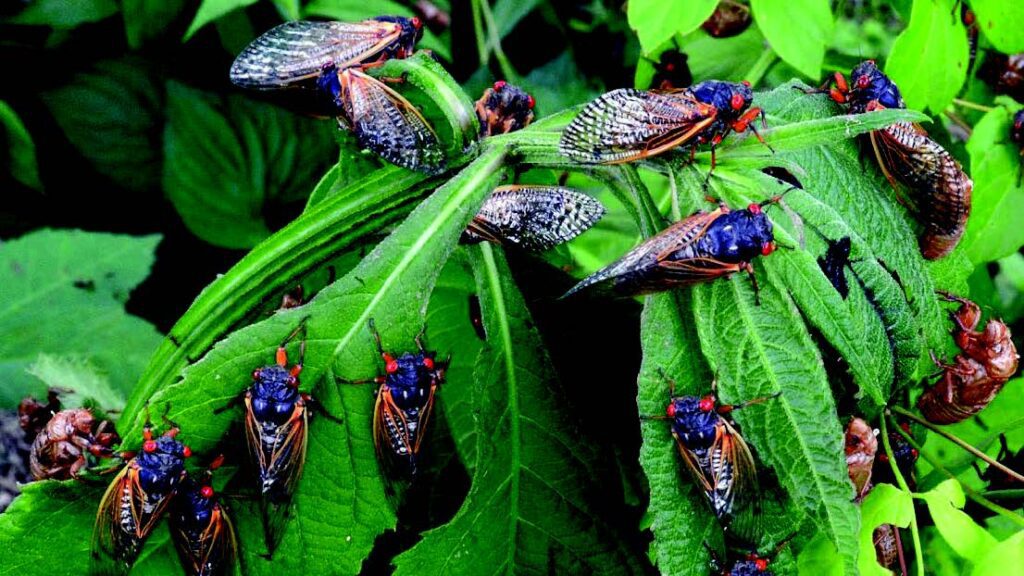Experts say the insects may be annoying but pose no threat to humans, pets or gardens

In an event that hasn’t happened since the country purchased the Louisiana Territory from the French and Thomas Jefferson was president, bugs will emerge from the ground and descend on the contiguous United States this spring.
The bugs we’re referencing are cicadas, specifically two distinct populations of periodical cicadas. These groups, known as Broods XIX and XIII, only emerge every 13 and 17 years, respectively.
But this year, in an almost ominous fashion, the two population’s emergence will happen together for the first time since 1803. And whether or not we see them in Louisiana could be another history-making event, according to one scientist.
Here’s why.
A historic emergence
Periodical cicadas spend most of their life underground as nymphs, feeding on sap and tree roots, according to the National Museum of Natural History. Every 13 or 17 years (depending on the species) they emerge as adults to mate and lay eggs.
They emerge in groups, which scientists have called broods to help us track which family of bugs come out during which years.
In April, Brood XIII, known as the Northern Illinois Brood, and Brood XIX, known as the Great Southern Brood, are set to emerge at the same time in a very rare occurrence. Smithsonian entomologist Floyd Shockley expects that these coupled emergences could produce more than one trillion cicadas, the Natural History Museum said.
Thankfully, Illinois is the only state expected to see cicadas from both broods. Louisiana would only see cicadas from Brood XIX in its northeastern-most parishes.
But whether our state will see any of them at all is a rising question.
Possible extinction?
LSU Department of Entomology Emeritus Professor Christopher Carlton believes Brood XIX may be extinct in Louisiana due to logging and habitat destruction.
According to Aaron Ashbrook, an assistant professor at LSU’s Entomology department, the last time Brood XIX emerged in 2011, there were no records of sightings in Louisiana.
However, this possible extinction doesn’t mean we won’t see any cicadas at all in Louisiana anymore, Ashbrook says. In addition to periodical cicadas, there are also annual cicadas, which appear in Louisiana every year.
Like their periodical cousins, adult annual cicadas emerge from the ground to mate, just on a more regular basis. This is because they are a different species that require less time underground.
This variance in emergence patterns also prevents cicadas from competing with each other for a mate and potentially wasting time attempting to mate with a cicada from a different species, according to Ashbrook.
When the cicadas do emerge, you’ll of course hear their high pitched singing. But don’t worry, their loud noise doesn’t do damage to our ears.
The adults also don’t eat anything and aren’t considered pests.
Will cicadas harm your garden?
When cicadas emerge, gardeners may see the insects crawling over plants, but it’s nothing to worry about, said Paula Shrewsbury, an associate professor in the University of Maryland’s department of entomology.
“There’s very little evidence that cicadas do any damage at all,” said Shrewsbury, who is a member of UMD’s self-declared Cicada Crew and is teaching a graduate class about periodic cicadas this semester. Bugs quickly will move on to the trees where they mate and lay eggs.
Cicadas prefer to lay eggs on the outer parts of pencil-size branches, where they make a small slit and create egg nests. “Egg laying can damage the tips of the trees, and the tips of the trees will die back — it’s called flagging,” Shrewsbury said.
Older, established trees can easily recover from flagging. A small tree with a trunk diameter about 2 inches or less, though, could be vulnerable. That means it’s worth delaying new plantings, and protecting existing small trees.
“Insecticides are not the best option,” Shrewsbury said, adding that covering trees works better than chemicals. Insecticides could also harm the beneficial pollinators on which flowering trees and plants depend.
To cover small trees, enclose them in netting with holes smaller than a centimeter. Tie netting at the bottom to prevent the cicadas from crawling up, Shrewsbury said, being sure to secure the seam tightly, too.
Overall, she said, cicadas benefit gardens. When the insects emerge from the soil, they create holes that increase aeration and water penetration. Over the cicada life cycle, exoskeletons and dying adults will fall to the ground, breaking down into organic matter and nutrients that feed the soil.
Leave the cicada exoskeletons and bodies where they are, Shrewsbury said, or rake them up and toss onto your compost pile.
If you see ‘em, report ‘em
Given the potential extinction of Brood XIX, Carlton is asking citizen scientists in the northern parts of the state to report if they see any of the rare cicadas.
Cicadas belonging to Brood XIX will be black in color, with bright red eyes and golden veining in their wings, Ashbrook says. Don’t worry about confusing them with annual cicadas either; those are green and don’t have red eyes.
If you do spot them, Ashbrook recommends reporting them on the Bugwood website, or reaching out to the LSU Ag Center’s Department of Entomology using their inquiry page on their website.
 fgazette.com Community news site for Union Parish Louisiana
fgazette.com Community news site for Union Parish Louisiana